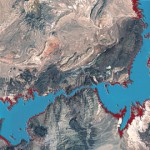The western U.S. has faced a full-blown drought for the past 5 years, and last fall’s shocking drought in the Southeast U.S. may be a harbinger of future problems. So it’s not too surprising that in the proposed budget for fiscal year 2009 (FY ’09), the Bush Administration has asked Congress to provide $3 million to the U.S. Geological Survey (USGS) to assess water use nationwide. At the same time, however, the administration has proposed slashing funding for USGS’s well-established National Water-Quality Assessment (NAWQA) program.
USGS water scientists have tracked water losses during the 5-year drought in the Colorado River basin, evident in drops in the level of Lake Mead, the recreational reservoir and water source created by the Hoover Dam for hydroelectric power. The red band shows water level decreases between 2000 and 2003.
Water experts are concerned about money being taken away from programs that assess water quality, even if it is to focus more on water quantity. “Water availability is, frankly, a growing impending crisis in this country,” says George Hallberg of The Cadmus Group, but he adds that both quality and quantity must be considered together. Hallberg notes several concerns for future water resource management that will impact both quality and quantity, including saltwater intrusion in coastal regions, wastewater treatment infrastructure issues, and contamination from surface runoff in urban and rural areas.
To pay for an inventory of water use in the U.S. (the first national assessment since the 1980s), other programs must be cut. NAWQA stands to lose 15% of its current funding, or nearly $10 million. That could lead to the elimination of 70 positions, mainly geochemists, according to USGS.
“Such reductions in NAWQA staff would be a major loss of intellectual capital with many years of experience assessing water quality over broad regions and long periods of time,” USGS officials wrote in a synopsis (70Kb PDF) of the cuts. Implications of the cuts also include the loss of testing for drinking-water quality in study areas that supply regions in seven states as well as the loss of data collection on 10 aquifers that feed drinking-water wells across the U.S.
“NAWQA is unique and irreplaceable,” says Eileen O’Neill of the Water Environment Federation. “The USGS proposed budget is down $38 million from the 2008 budget,” she comments, and the decrease “seems to disproportionately hit the water program,” particularly NAWQA. Other USGS programs facing budget cuts include three core areas for the Toxic Substances Hydrology Program: emerging environmental contaminants, pesticides in the environment, and watershed effects from hard-rock mining.
“Water is becoming a key management issue, and one that is going to put limits on social and economic growth,” particularly in light of climate change, Hallberg says. New modeling results published online in Water Resources Research estimate a 50% chance that Lake Mead will be completely dry by 2021, as a result of drought, evaporation, expected growth in demand for Colorado River water, and climate change. The researchers calculate that the amount of water lost would be enough to serve 8 million people.
“In the water management arena, we have never had a good database,” comments Tracy Mehan, a former U.S. EPA administrator who is now a consultant with the Cadmus Group. “Whether it’s ambient water-quality data or a water census, we need data to understand where the water uses are, so we can regulate them or manage” water properly. At odds with this mission, USGS has been losing stream gauges for many years, Mehan points out. Even in states like Michigan, which issued a $45 million state bond to collect 15 years of stream monitoring data, funding is running out.
On a more positive note, the administration’s FY ’09 budget request adds $5 million for USGS stream gauges. The question now becomes whether Congress will feel enough pressure to set money aside for NAWQA while also funding the much-needed national water census.

